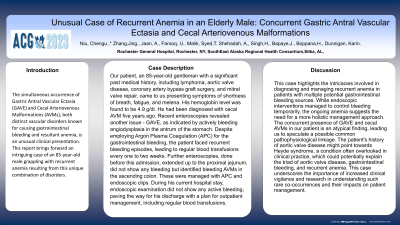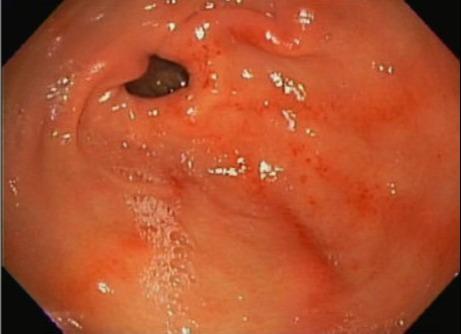Monday Poster Session
Category: GI Bleeding
P2077 - Unusual Case of Recurrent Anemia in an Elderly Male: Concurrent Gastric Antral Vascular Ectasia and Cecal Arteriovenous Malformations
Monday, October 23, 2023
10:30 AM - 4:15 PM PT
Location: Exhibit Hall

Has Audio
- CN
Chengu Niu, MD
Rochester General Hospital
Rochester, NY
Presenting Author(s)
Chengu Niu, MD1, Tausif Syed, MD1, Ali Jaan, MD1, Umer Farooq, MD1, Sheza Malik, MD1, Ahmed Shehadah, MD1, Harkarandeep Singh, MD1, Jay Bapaye, MD1, Hemanth Boppana, MD2, Jing Zhang, MD3, Karin Dunnigan, MD1
1Rochester General Hospital, Rochester, NY; 2Rochester General hospital, Rochester, NY; 3Rainier Springs Hospital, Vancouver, WA
Introduction: The simultaneous occurrence of Gastric Antral Vascular Ectasia (GAVE) and Cecal Arteriovenous Malformations (AVMs), both distinct vascular disorders known for causing gastrointestinal bleeding and resultant anemia, is an unusual clinical presentation. This report brings forward an intriguing case of an 85-year-old male grappling with recurrent anemia resulting from this unique combination of disorders.
Case Description/Methods: Our patient, an 85-year-old gentleman with a significant past medical history, including lymphoma, aortic valve disease, coronary artery bypass graft surgery, and mitral valve repair, came to us presenting symptoms of shortness of breath, fatigue, and melena. His hemoglobin level was found to be 4.9 g/dl. He had been diagnosed with cecal AVM five years ago. Recent enteroscopies revealed another issue - GAVE, as indicated by actively bleeding angiodysplasia in the antrum of the stomach. Despite employing Argon Plasma Coagulation (APC) for the gastrointestinal bleeding, the patient faced recurrent bleeding episodes, leading to regular blood transfusions every one to two weeks. Further enteroscopies, done before this admission, extended up to the proximal jejunum, did not show any bleeding but identified bleeding AVMs in the ascending colon. These were managed with APC and endoscopic clips. During his current hospital stay, endoscopic examination did not show any active bleeding, paving the way for his discharge with a plan for outpatient management, including regular blood transfusions.
Discussion: This case highlights the intricacies involved in diagnosing and managing recurrent anemia in patients with multiple potential gastrointestinal bleeding sources. While endoscopic interventions managed to control bleeding temporarily, the ongoing anemia suggests the need for a more holistic management approach. The concurrent presence of GAVE and cecal AVMs in our patient is an atypical finding, leading us to speculate a possible common pathophysiological linkage. The patient's history of aortic valve disease might point towards Heyde syndrome, a condition often overlooked in clinical practice, which could potentially explain the triad of aortic valve disease, gastrointestinal bleeding, and recurrent anemia. This case underscores the importance of increased clinical vigilance and research in understanding such rare co-occurrences and their impacts on patient management.

Disclosures:
Chengu Niu, MD1, Tausif Syed, MD1, Ali Jaan, MD1, Umer Farooq, MD1, Sheza Malik, MD1, Ahmed Shehadah, MD1, Harkarandeep Singh, MD1, Jay Bapaye, MD1, Hemanth Boppana, MD2, Jing Zhang, MD3, Karin Dunnigan, MD1. P2077 - Unusual Case of Recurrent Anemia in an Elderly Male: Concurrent Gastric Antral Vascular Ectasia and Cecal Arteriovenous Malformations, ACG 2023 Annual Scientific Meeting Abstracts. Vancouver, BC, Canada: American College of Gastroenterology.
1Rochester General Hospital, Rochester, NY; 2Rochester General hospital, Rochester, NY; 3Rainier Springs Hospital, Vancouver, WA
Introduction: The simultaneous occurrence of Gastric Antral Vascular Ectasia (GAVE) and Cecal Arteriovenous Malformations (AVMs), both distinct vascular disorders known for causing gastrointestinal bleeding and resultant anemia, is an unusual clinical presentation. This report brings forward an intriguing case of an 85-year-old male grappling with recurrent anemia resulting from this unique combination of disorders.
Case Description/Methods: Our patient, an 85-year-old gentleman with a significant past medical history, including lymphoma, aortic valve disease, coronary artery bypass graft surgery, and mitral valve repair, came to us presenting symptoms of shortness of breath, fatigue, and melena. His hemoglobin level was found to be 4.9 g/dl. He had been diagnosed with cecal AVM five years ago. Recent enteroscopies revealed another issue - GAVE, as indicated by actively bleeding angiodysplasia in the antrum of the stomach. Despite employing Argon Plasma Coagulation (APC) for the gastrointestinal bleeding, the patient faced recurrent bleeding episodes, leading to regular blood transfusions every one to two weeks. Further enteroscopies, done before this admission, extended up to the proximal jejunum, did not show any bleeding but identified bleeding AVMs in the ascending colon. These were managed with APC and endoscopic clips. During his current hospital stay, endoscopic examination did not show any active bleeding, paving the way for his discharge with a plan for outpatient management, including regular blood transfusions.
Discussion: This case highlights the intricacies involved in diagnosing and managing recurrent anemia in patients with multiple potential gastrointestinal bleeding sources. While endoscopic interventions managed to control bleeding temporarily, the ongoing anemia suggests the need for a more holistic management approach. The concurrent presence of GAVE and cecal AVMs in our patient is an atypical finding, leading us to speculate a possible common pathophysiological linkage. The patient's history of aortic valve disease might point towards Heyde syndrome, a condition often overlooked in clinical practice, which could potentially explain the triad of aortic valve disease, gastrointestinal bleeding, and recurrent anemia. This case underscores the importance of increased clinical vigilance and research in understanding such rare co-occurrences and their impacts on patient management.

Figure: Gastric Antral Vascular Ectasia
Disclosures:
Chengu Niu indicated no relevant financial relationships.
Tausif Syed indicated no relevant financial relationships.
Ali Jaan indicated no relevant financial relationships.
Umer Farooq indicated no relevant financial relationships.
Sheza Malik indicated no relevant financial relationships.
Ahmed Shehadah indicated no relevant financial relationships.
Harkarandeep Singh indicated no relevant financial relationships.
Jay Bapaye indicated no relevant financial relationships.
Hemanth Boppana indicated no relevant financial relationships.
Jing Zhang indicated no relevant financial relationships.
Karin Dunnigan indicated no relevant financial relationships.
Chengu Niu, MD1, Tausif Syed, MD1, Ali Jaan, MD1, Umer Farooq, MD1, Sheza Malik, MD1, Ahmed Shehadah, MD1, Harkarandeep Singh, MD1, Jay Bapaye, MD1, Hemanth Boppana, MD2, Jing Zhang, MD3, Karin Dunnigan, MD1. P2077 - Unusual Case of Recurrent Anemia in an Elderly Male: Concurrent Gastric Antral Vascular Ectasia and Cecal Arteriovenous Malformations, ACG 2023 Annual Scientific Meeting Abstracts. Vancouver, BC, Canada: American College of Gastroenterology.
